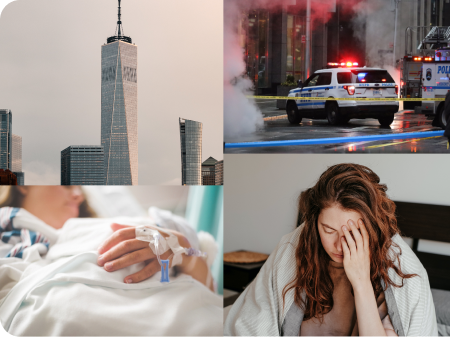Subway grates are a familiar part of the New York City streetscape. But when they stick up above the pavement or break apart, they can become dangerous hazards. If you suffered an injury after a trip over a subway grate in NYC, you may wonder whether you can file a legal claim.
In this post, we explain your rights, who may be responsible, and what steps to take after a fall involving a defective or raised subway grate in New York City.
Trip and Fall Over a Subway Grate in New York? Reach Out to Ferrante & Koenig 24/7 for a Free Consult.
Yes, You May Be Able to File a Claim
If you tripped over a raised, broken, or unstable subway grate and were injured, you may have grounds for a personal injury claim. These cases fall under premises or municipal liability, depending on who controls the area where the grate is located.
To succeed, you must prove that someone was negligent in maintaining the grate and that their failure caused your injury.
Common Subway Grate Hazards That Cause Falls
Subway grates should be level with the surrounding sidewalk. But when they’re not properly maintained, they can pose serious trip hazards. Common issues include:
- Raised or uneven grates that stick up above the sidewalk,
- Loose or unstable grates that shift when stepped on,
- Broken or missing sections of the grate,
- Poor lighting or lack of visibility around the grate,
- Cracked pavement around the edge of the grate, and
- Ice or debris collecting in or around the grate.
Even a one-inch height difference can cause someone to catch their foot and fall. These cases often involve facial injuries, wrist fractures, or head trauma from the impact.
Who Is Responsible for the Grate?
Liability depends on who owns, controls, and maintains the area where the accident occurred. Trips over a subway grate in NYC are typically associated with the MTA or Con Edison, but not always.
Possible liable parties include:
- Metropolitan Transportation Authority (MTA). The MTA is responsible for many subway-related structures, including ventilation grates above underground stations.
- City of New York. If the grate is owned or maintained by the city or installed on city-owned property, you may need to file a claim against the city.
- Con Edison or other utilities. Some grates cover electrical or steam systems and are owned by utility companies.
- Private property owners. Sometimes, a building owner may be responsible for the sidewalk area in front of their property, even if it includes a subway grate.
Due to this complexity, identifying the correct defendant is crucial but not always straightforward.
How to Determine Who Owns the Subway Grate
A personal injury attorney can investigate ownership by:
- Reviewing city maps and maintenance logs,
- Submitting Freedom of Information Law (FOIL) requests,
- Visiting the site and taking photographs,
- Researching prior complaints or similar accidents at the same location, and
- Identifying any utility access markings near the grate.
Ownership determines who you can sue and what rules and deadlines apply.
What You Must Prove to Have a Valid Claim
Regardless of the responsible party, you must prove that:
- A dangerous condition existed, such as a raised or broken grate;
- The responsible party either created the condition or knew or should have known about it;
- They failed to fix it or warn about it in a reasonable time; and
- You were injured as a result.
These are the legal elements of a premises liability claim. You must also demonstrate your injuries and the value of your damages.
Special Rules for Government Entities
If the MTA or the City of New York is responsible for your fall, you must follow specific procedures that differ from claims against private property owners.
Filing a claim against the MTA involves:
- Notice of Claim. You must file this document within 90 days of your fall.
- Lawsuit Deadline. You have one year and 90 days to file a lawsuit after the incident.
- Hearing. The MTA may require a hearing under General Municipal Law § 50-h.
Filing a claim against the city involves a similar notice of claim process and the same statute of limitations. Then you have to identify which department to involve.
What Evidence Will Strengthen Your Case?
The more proof you can gather, the better your chances of success. After a trip over a subway grate in NYC, try to obtain:
- Photos of the grate and the surrounding area immediately after the fall,
- Medical records linking your injuries to the fall,
- Witness statements from anyone nearby,
- Surveillance footage if the incident was near a business,
- Maintenance records showing prior complaints or inspections,
- Documentation of lost income if you missed work, and
- Incident reports if EMS or police responded to the scene.
Preserving evidence early is critical. These grates may be repaired or altered days later, making it harder to prove the condition at the time of the fall.
SETTLEMENTS & VERDICTS
We’ve recovered millions for victims of slip and fall accidents in New York.
What Damages Can You Recover?
If your claim is successful, you may recover compensation for:
- Emergency care and medical treatment,
- Follow-up care or physical therapy,
- Lost wages or reduced earning capacity,
- Pain and suffering, and
- Disfigurement or disability.
The amount depends on the seriousness of your injury, the strength of your evidence, and the degree of fault.
Contact Ferrante & Koenig, PLLC
If you were injured, do not assume you have no legal options. With the proper evidence and legal team, you may be able to recover significant compensation for your injuries, lost income, and pain. However, time is short, especially if a public entity is involved.
Contact Ferrante & Koenig, PLLC, today for a free consultation. Let us put our significant experience with premises liability cases to work for you.



















